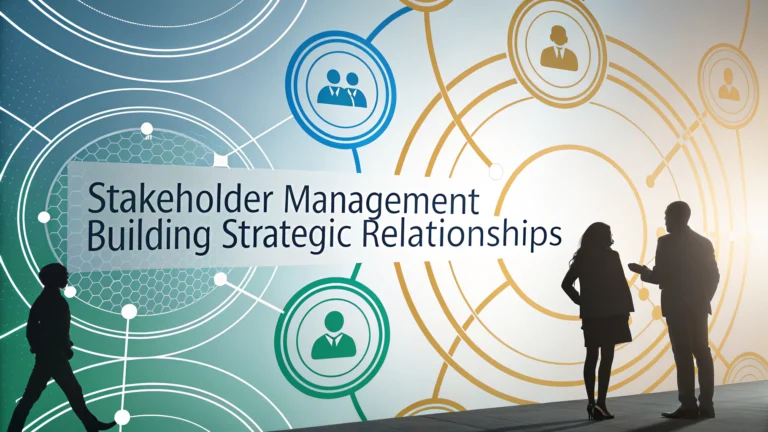Building strong relationships with stakeholders is a fundamental responsibility of any chief operating officer, directly impacting organizational success and sustainable growth.
Strategic stakeholder management requires a systematic approach to identify, prioritize, and effectively engage with individuals and groups who can influence or are affected by business operations.
This guide outlines proven strategies for COOs to develop and maintain productive stakeholder relationships while navigating complex business environments.
Identifying Key Stakeholders
- Board members and executives
- Employees and department heads
- Customers and clients
- Suppliers and vendors
- Regulatory bodies
- Investors and shareholders
- Local communities
Stakeholder Analysis Framework
| Power Level | Interest Level | Management Strategy |
|---|---|---|
| High | High | Manage Closely |
| High | Low | Keep Satisfied |
| Low | High | Keep Informed |
| Low | Low | Monitor |
Communication Best Practices
Establish regular communication channels tailored to each stakeholder group’s preferences and needs.
- Board Members: Monthly reports, quarterly presentations
- Employees: Town halls, internal newsletters, feedback sessions
- Customers: Satisfaction surveys, focus groups, advisory panels
- Suppliers: Regular review meetings, performance updates
- Investors: Financial reports, strategy updates, annual meetings
Building Trust and Credibility
Maintain transparency in all communications, sharing both successes and challenges openly.
Follow through on commitments and promises made to stakeholders.
Demonstrate ethical leadership and consistent decision-making practices.
Conflict Resolution Strategies
- Address issues promptly and directly
- Listen actively to all parties involved
- Focus on finding mutually beneficial solutions
- Document agreements and follow-up actions
- Monitor resolution progress
Measuring Stakeholder Engagement
Track engagement metrics through regular surveys and feedback mechanisms.
- Employee satisfaction scores
- Customer retention rates
- Supplier performance metrics
- Investor confidence indicators
- Community feedback ratings
Tools and Resources
Utilize stakeholder management software and tools to streamline relationship management:
- Salesforce: Customer relationship management
- Monday.com: Project and stakeholder tracking
- Tableau: Data visualization for stakeholder reporting
- Microsoft Teams: Communication and collaboration
Moving Forward with Stakeholder Relations
Review and update your stakeholder management strategy quarterly to ensure alignment with organizational goals.
Document lessons learned and successful engagement practices for future reference.
Invest in continuous improvement of stakeholder relationships through regular feedback and adaptation.
Risk Management in Stakeholder Relations
Develop comprehensive risk mitigation strategies for stakeholder-related challenges:
- Regulatory compliance monitoring
- Reputation management protocols
- Crisis communication plans
- Stakeholder feedback analysis
- Early warning systems for potential issues
Developing Long-term Partnerships
Strategic Alignment
- Create shared value propositions
- Establish long-term collaborative goals
- Develop mutual growth opportunities
- Build strategic alliances
Value Creation
- Joint innovation initiatives
- Resource optimization
- Knowledge sharing platforms
- Sustainable partnership models
Digital Transformation in Stakeholder Management
Leverage technology to enhance stakeholder engagement:
- AI-powered analytics for stakeholder insights
- Digital platforms for real-time communication
- Automated reporting systems
- Virtual collaboration tools
Strengthening Stakeholder Relationships for Future Success
Effective stakeholder management remains a critical driver of organizational success. COOs must continuously evolve their approach to meet changing stakeholder expectations and market dynamics.
Focus on building sustainable, mutually beneficial relationships that create long-term value for all parties involved.
Remember that successful stakeholder management is an ongoing journey requiring dedication, adaptability, and strategic vision to maintain positive engagement and drive organizational growth.
FAQs
- What is stakeholder management and why is it crucial for a COO?
Stakeholder management is the systematic process of identifying, analyzing, engaging with, and monitoring individuals or groups who can affect or be affected by an organization’s activities. For a COO, it’s crucial because effective stakeholder management ensures operational efficiency, risk mitigation, and successful implementation of strategic initiatives. - How can a COO identify and prioritize key stakeholders?
COOs can identify and prioritize stakeholders using power/interest matrices, analyzing stakeholder influence and impact levels, and evaluating their role in operational success. Priority should be given to stakeholders with high power and high interest in the organization’s operations. - What are the most effective communication strategies for stakeholder engagement?
Effective communication strategies include regular status updates, personalized communication channels, transparent reporting mechanisms, scheduled face-to-face meetings, and tailored messaging based on stakeholder interests and preferences. - How should a COO manage conflicting stakeholder interests?
COOs should address conflicting interests by finding common ground, facilitating open dialogue, establishing clear priorities aligned with organizational goals, and developing compromise solutions that balance different stakeholder needs. - What role does stakeholder management play in change management?
Stakeholder management is essential in change management as it helps secure buy-in, reduce resistance, ensure smooth implementation of changes, and maintain stakeholder support throughout the transformation process. - How can COOs measure the effectiveness of their stakeholder management efforts?
Effectiveness can be measured through stakeholder satisfaction surveys, engagement levels, project success rates, feedback mechanisms, relationship quality assessments, and the achievement of mutual objectives. - What are the common pitfalls in stakeholder management that COOs should avoid?
Common pitfalls include poor communication, neglecting certain stakeholder groups, failing to manage expectations, inconsistent engagement, not following through on commitments, and underestimating the impact of stakeholder relationships on operational success. - How can COOs build long-term strategic relationships with stakeholders?
Building long-term relationships requires consistent engagement, delivering on promises, maintaining transparency, showing genuine interest in stakeholder concerns, creating mutual value, and establishing trust through reliable performance and ethical behavior. - What tools and technologies can support effective stakeholder management?
Useful tools include stakeholder mapping software, CRM systems, communication platforms, project management tools, feedback collection systems, and analytics tools for tracking engagement and relationship metrics. - How should COOs handle crisis communication with stakeholders?
Crisis communication requires immediate response, transparent information sharing, clear action plans, regular updates, maintaining accessibility, and demonstrating leadership in addressing stakeholder concerns and mitigating impacts.
